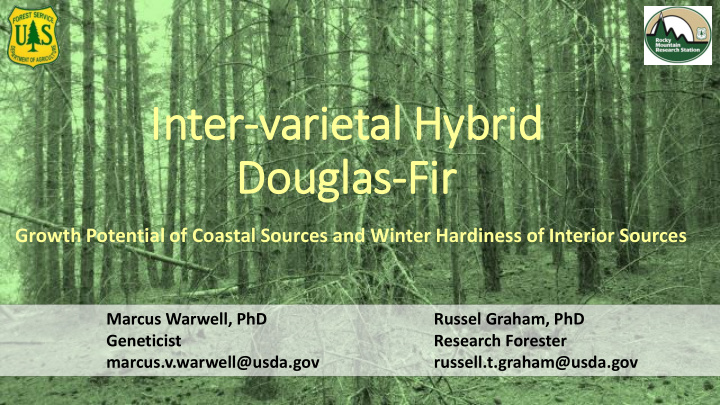



In Inter-varietal Hybrid id Dougla las-Fir ir Growth Potential of Coastal Sources and Winter Hardiness of Interior Sources Marcus Warwell, PhD Russel Graham, PhD Geneticist Research Forester marcus.v.warwell@usda.gov russell.t.graham@usda.gov
Key Management Point: • Hybrid Douglas-fir is outperforming interior and coastal parent sources in Northern Idaho.
Outline • Background on Hybrid Douglas-fir • Overview of published research • Current work
Douglas-Fir Varieties Coastal Interior Interior Growth a Variety Rhabdocline pseudotsugae Coastal Tolerance Variety Cold Hardiness Drought Hardiness Shade Tolerance a • Coastal Douglas-fir: Second tallest Conifer • Interior Douglas-fir: - 40 ° C • Varieties are completely interfertile
Genetic Structure of Douglas-Fir
Genetic Structure of Douglas-Fir
Genetic Structure of Douglas-Fir - Clinal Variation in Growth Potential
Management opportunities: • Increased climatic resilience • Increased productivity “…Thus it seems likely that planting stock combining specific site adaptation and rapid growth can be produced by racial crossing. – Duffield, 1950 Jerry Rehfeldt
Growth and Cold Hardiness Testing of Inter-varietal Hybrid Douglas-fir Lake Cowichan, BC • Coastal Douglas-fir - 15 Paternal half-sib families Clarkia, ID • Interior Douglas-fir - 18 Maternal half-sib Valsetz, OR Moscow, ID families Lacomb, OR
Hybrid Douglas-fir • Coeur d’ Alene Nursery Test Results • Planted as seed in 1971 • 70 full-sib hybrid families • 33 half-sib families from parental lines
Hybrid Douglas-fir Test Results • Winter drought in 1972 - as low as - 26 °C - Interior: 44% Survival - Hybrid: 44% Survival - Coastal: 9% Survival • Traits - Specific Combining effects - Weak additive for Growth Potential - Intermediate for other adaptive traits
Rehfeldt, 1977
-40 -35 Cold Hardiness Development Through Temperature (°C) -30 Fall -25 -20 -15 Interior Var. Coastal Var. -10 Hybrid 24-25 4-5 28-29 15-16 Rehfeldt, 1977 Sept Nov Nov Oct
Green Creek Field Test Elevation : 3400 feet Latitude: 46 degrees Longitude:116 degrees • 3 year-old (1-2) stock planted in 1975 • 70 full-sib hybrid families • Fewer than 33 half-sib families from parental lines
Gree een Cr Cree eek Fie Field d Tes est • 10 year field trial: - Hybrid survival = interior parents - Hybrid height was ~2 x height of interior parents
Naturaliz izatio ion in Eu Europe • Douglas-fir introduced/naturalized in > 30 European countries • intraspecific genetic admixture contributes significantly to the invasive success of non-native species • Increased pool of raw material for adaptive evolution (by T. Eckhart) (Spiecker et al ., 2019)
Coastal Hybrid Interior. Braun, 1998
Braun, 1998
Hybrid forward selection(s) in the BC Ministry breeding orchard at Kalamalka . Photo by: Florian Deisenhofer
Gree een Cr Cree eek Fie Field d Tes est t 44 years after planting Excellent growth and survival of the Hybrid families was obvious. “ Realization of the tremendous potential of hybridization for improvement of the interior variety will requireat least one backcross generation or additional crosses utilizing introgressed populations .” – Rehfeldt, 1977
Gree een Cr Cree eek Fie Field d Tes est t 44 years after planting
DBH (inches) 10.5 9.5 7.7 Surv = 13% Surv = 50% Surv = 29 % n = 43 n = 587 n = 87 Preliminary results based on ¾ of test measured, does not consider density dependent competition
Photo by: Florian Deisenhofer
Hybrid Douglas-fir Moscow Forest Sciences Laboratory Moscow, Idaho Planted: ~ 1975
Hybrid Douglas-fir Moscow Forest Sciences Laboratory Moscow, Idaho Planted: ~ 1975 DBH: 23.1 inches
PREF Clonal Orchard - Planted in 1996 using best performing crosses and parent clones at Green Creek - Assess Trait Segregation - Assessing Backcross Performance - Hybrid Breakdown
IETIC working with NWTIC (Northwest Tree Improvement Coop) to cross top performers from the inland and the coast • Medford OR orchard will be used to create hybrid crosses this spring. Potential Production Approaches: Photo by: Nathan Hanzelka - Top Grafting ? - Controlled Mass Pollination ? - Micropropagation via somatic embryogenesis ?
Florian Deisenhofer Silviculture Manager Hancock Forest Management, A Manulife Investment Management Company • E fdeisenhofer@hnrg.com T 360 635 5804 (office) T 360 949 2393 (cell) 17700 SE Mill Plain Blvd., Suite 180 Vancouver, WA 98683
Acknowledgements Jerry Rehfeldt Marc Rust Director Research Geneticist, RET. IETIC USDA FS, RMRS Russ Graham Research Forester Ross Applegren USDA FS, RMRS Forester Eric Berard IETIC Silvicultural Forester Hancock Forest Management
Key Management Point: • Hybrid Douglas-fir is outperforming interior and coastal parent sources in Northern Idaho. Marcus Warwell, PhD Geneticist USDA FS RMRS marcus.v.warwell@usda.gov
Recommend
More recommend